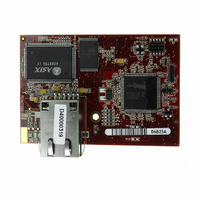20-101-1067 Rabbit Semiconductor, 20-101-1067 Datasheet - Page 20

20-101-1067
Manufacturer Part Number
20-101-1067
Description
MODULE RABBITCORE RCM3305
Manufacturer
Rabbit Semiconductor
Datasheet
1.20-101-1068.pdf
(160 pages)
Specifications of 20-101-1067
Module/board Type
MPU Core Module
Product
Microcontroller Modules
Flash
512 KBytes
Timers
10 bit
Operating Supply Voltage
3.15 to 3.45 V
Board Size
47 mm x 69 mm x 22 mm
For Use With/related Products
RCM3305
Lead Free Status / RoHS Status
Lead free / RoHS Compliant
Other names
316-1113
Available stocks
Company
Part Number
Manufacturer
Quantity
Price
- Current page: 20 of 160
- Download datasheet (4Mb)
2.3 Starting Dynamic C
Once the RCM3305 series module is connected as described in the preceding pages, start
Dynamic C by double-clicking on the Dynamic C icon on your desktop or in your
menu. Select
Dynamic C
If you are using a USB port to connect your computer to the RCM3305/RCM3315 module,
choose
Communications
2.4 Run a Sample Program
Use the
SAMPLES
dow will open on your PC and will display a small square bouncing around in a box.
This program shows that the CPU is working. The sample program described in
Section 6.5, “Run the PINGME.C Sample Program,” tests the TCP/IP portion of the board.
2.4.1 Troubleshooting
If Dynamic C cannot find the target system (error message "No Rabbit Processor
Detected."):
• Check that the RCM3305 series module is powered correctly — the red
• Check both ends of the programming cable to ensure that they are firmly plugged into
• Ensure that the RCM3305 series module is firmly and correctly installed in its connec-
• Dynamic C uses the COM port or USB port specified during installation. Select a dif-
• If you get an error message when you plugged the programming cable into a USB port,
14
the Prototyping Board should be lit when the module is mounted on the Prototyping Board and
the AC adapter is plugged in
the PC and the
ming port on the RCM3305 series module with the marked (colored) edge of the pro-
gramming cable towards pin 1 of the programming header.
tors on the Prototyping Board.
ferent COM port within Dynamic C. From the
then select
Press
is unable to locate the target system, repeat the above steps until you locate the COM
port used by the programming cable.
you will have to install USB drivers. Drivers for Windows XP are available in the
Dynamic C
double-click
tems are available online at www.ftdichip.com/Drivers/VCP.htm.
NOTE: Dynamic C v. 9.60 or a later version is required if you are using an RCM3309 or
Options > Project Options
File
<Ctrl-Y>
an RCM3319 RabbitCore module.
folder. Press function key
Options > Project Options
menu to open the sample program
Code and BIOS in Flash, Run in RAM
Communications
Drivers\Rabbit USB Programming Cable\WinXP_2K
DPInst.exe
PROG
to force Dynamic C to recompile the BIOS. If Dynamic C still reports it
tab. Click
connector, not the
.
OK
to install the USB drivers. Drivers for other operating sys-
. Select another COM port from the list, then click
.
F9
and select “Use USB to Serial Converter” on the
to compile and run the program. The
menu. Click
DIAG
PONG.C
Options
connector, is plugged in to the program-
OK
on the “Compiler” tab in the
, which is in the Dynamic C
.
menu, select
RabbitCore RCM3305/RCM3315
Project Options
CORE LED on
STDIO
folder —
Start
OK
win-
.
,
Related parts for 20-101-1067
Image
Part Number
Description
Manufacturer
Datasheet
Request
R

Part Number:
Description:
COMPUTER SGL-BRD BL2500 29.4MHZ
Manufacturer:
Rabbit Semiconductor
Datasheet:

Part Number:
Description:
COMPUTER SGL-BRD BL2500 29.4MHZ
Manufacturer:
Rabbit Semiconductor
Datasheet:

Part Number:
Description:
DISPLAY GRAPHIC 12KEY PROG OP670
Manufacturer:
Rabbit Semiconductor
Datasheet:

Part Number:
Description:
DISPLAY GRAPHIC 12KEY ETH OP6700
Manufacturer:
Rabbit Semiconductor
Datasheet:

Part Number:
Description:
COMPUTER SINGLE-BOARD BL2030
Manufacturer:
Rabbit Semiconductor

Part Number:
Description:
COMPUTER SGL-BOARD ETH BL2010
Manufacturer:
Rabbit Semiconductor

Part Number:
Description:
MODULE OP6810 W/O ETH/MEM EXPANS
Manufacturer:
Rabbit Semiconductor
Datasheet:

Part Number:
Description:
COMPUTER SINGLE-BOARD BL2020
Manufacturer:
Rabbit Semiconductor

Part Number:
Description:
COMPUTER BL2010 W/FRICTION LOCK
Manufacturer:
Rabbit Semiconductor

Part Number:
Description:
COMPUTER BL2020 W/FRICTION LOCK
Manufacturer:
Rabbit Semiconductor

Part Number:
Description:
COMPUTER SGL-BRD BL2500 44.2MHZ
Manufacturer:
Rabbit Semiconductor
Datasheet:

Part Number:
Description:
COMPUTER SGL-BOARD FULL BL2000
Manufacturer:
Rabbit Semiconductor

Part Number:
Description:
COMPUTER SINGLE-BOARD BL2110
Manufacturer:
Rabbit Semiconductor

Part Number:
Description:
COMPUTER SGL-BRD 29.4MHZ BL2610
Manufacturer:
Rabbit Semiconductor
Datasheet:

Part Number:
Description:
INTERFACE OP6800 512K FLASH&SRAM
Manufacturer:
Rabbit Semiconductor
Datasheet:











